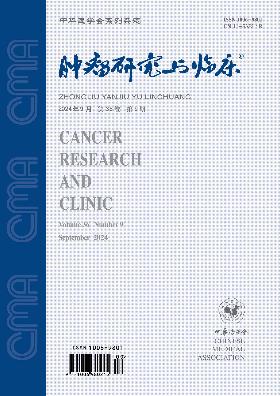肌动蛋白相关蛋白2/3复合体亚基2基因沉默对甲状腺乳头状癌TPC-1细胞增殖和凋亡的影响
Q4 Medicine
引用次数: 0
摘要
目的通过慢病毒介导的RNA干扰研究肌动蛋白相关蛋白2/3复合亚基2(ARPC2)基因沉默对甲状腺乳头状癌(PTC)TPC-1细胞生物学特性的影响。方法用无义短发夹RNA(shRNA)序列慢病毒(shCtrl)感染TPC-1细胞作为对照组。以ARPC2 shRNA干扰序列慢病毒(shARPC2)感染的TPC-1细胞为实验组,对ARPC2基因的表达进行特异性干扰。采用MTT法、流式细胞仪、Western blot和集落形成试验等方法检测了ARPC2基因沉默对TPC-1细胞增殖的影响。采用流式细胞术和Western印迹法检测ARPC2基因沉默对TPC-1细胞凋亡及相关蛋白的影响。结果shARPC2能有效感染TPC-1细胞,绿色荧光蛋白的表达效率可达85%以上。与对照组相比,实验组TPC-1的增殖受到抑制。实验组S期细胞比例较对照组降低[(14.79±0.21)%vs.(21.13±0.33)%,t=27.77,P<0.05]。实验组G1期和G2/M期细胞比例与对照组相比增加[G1期:(67.57±0.08)%vs%同时,实验组细胞周期相关蛋白CDK2、CyclinE和CyclinD的表达降低。实验组克隆形成数少于对照组,差异有统计学意义[(10±2)vs.(161±6),t=9.011,P<0.05],实验组细胞凋亡率高于对照组[(8.60±0.77)%vs.(4.08±0.40)%,t=9.011,P<0.05]。结论干扰shRNA调控的ARPC2表达可抑制PTC TPC-1细胞的增殖,促进细胞凋亡,表明ARPC2可能是治疗PTC的一个新的生物学靶点。关键词:甲状腺肿瘤;RNA干扰;细胞增殖;细胞凋亡本文章由计算机程序翻译,如有差异,请以英文原文为准。
Effect of actin related protein 2/3 complex subunit 2 gene silencing on the proliferation and apoptosis of papillary thyroid carcinoma TPC-1 cells
Objective
To investigate the effect of actin related protein 2/3 complex subunit 2 (ARPC2) gene silencing on the biological characteristics of papillary thyroid carcinoma (PTC) TPC-1 cells through lentivirus-mediated RNA interference.
Methods
TPC-1 cells infected with nonsense short hairpin RNA (shRNA) sequence lentivirus (shCtrl) was used as the control group. TPC-1 cells infected with ARPC2 shRNA interference sequence lentivirus (shARPC2) was used as the experimental group, in which the expression of ARPC2 gene was specifically interfered. The effects of silencing the expression of ARPC2 gene on the proliferation of TPC-1 cells were detected by using methyl thiazolyl tetrazolium (MTT) assay, flow cytometry, Western blot and colony formation test. Flow cytometry and Western blot were conducted to detect the effect of silencing ARPC2 gene on TPC-1 cells apoptosis and related proteins.
Results
shARPC2 could efficiently infect TPC-1 cells, and the expression efficiency of green fluorescent protein was over 85%. Compared with the control group, TPC-1 proliferation was inhibited in the experimental group. The ratio of S-phase cells in the experimental group was reduced compared with that in the control group [(14.79±0.21)% vs. (21.13±0.33)%, t = 27.77, P < 0.05]. The ratio of G1 and G2/M-phase cells in the experimental group was increased compared with that in the control group [G1 phase: (67.57±0.08)% vs. (62.06±0.36)%, t=25.56, P < 0.05; G2/M phase: (17.64±0.12)% vs. (16.91±0.17)%, t=6.154, P < 0.05]. Meanwhile, the expressions of cell cycle-related proteins CDK2, CyclinE and CyclinD were reduced in the experimental group. The number of clone formation in the experimental group was less than that in the control group, the difference was statistically significant [(10±2) vs. (161±6), t=9.011, P < 0.05]. In addition, the apoptotic ratio of cells in the experimental group was higher than that in the control group [(8.60±0.77)% vs. (4.08±0.40)%, t=9.011, P < 0.05]. Western blot showed that the expressions of anti-apoptotic factors p21 and bcl-2 were reduced in the experimental group, while the expression of pro-apoptotic factor bax was increased.
Conclusion
The interference with the expression of ARPC2 regulated by shRNA can inhibit the proliferation, and promote the apoptosis of PTC TPC-1 cells, indicating that ARPC2 may be a possible biological new target for the treatment of PTC.
Key words:
Thyroid neoplasms; RNA interference; Cell proliferation; Apoptosis
求助全文
通过发布文献求助,成功后即可免费获取论文全文。
去求助
来源期刊

肿瘤研究与临床
Medicine-Oncology
CiteScore
0.10
自引率
0.00%
发文量
7737
期刊介绍:
"Cancer Research and Clinic" is a series of magazines of the Chinese Medical Association under the supervision of the National Health Commission and sponsored by the Chinese Medical Association.
It mainly reflects scientific research results and academic trends in the field of malignant tumors. The main columns include monographs, guidelines and consensus, standards and norms, treatises, short treatises, survey reports, reviews, clinical pathology (case) discussions, case reports, etc. The readers are middle- and senior-level medical staff engaged in basic research and clinical work on malignant tumors.
 求助内容:
求助内容: 应助结果提醒方式:
应助结果提醒方式:


